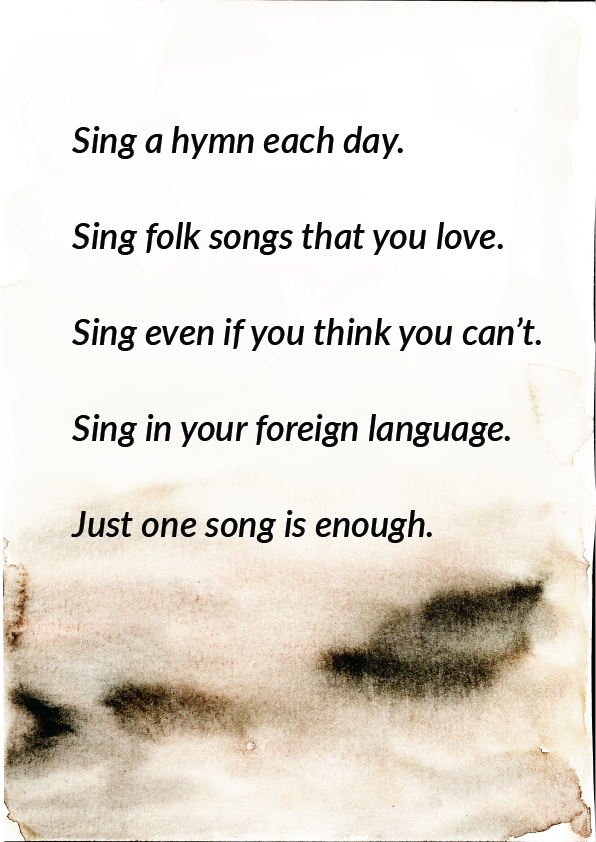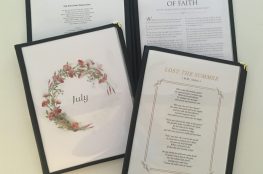 Songs can be some of the best tools for helping your homeschool day go more smoothly. Do your children struggle with transitions? Let a song be your cue to switch gears. Do your children need frequent wiggle breaks? Have an impromptu dance party. Do you need to get your children settled and focused again? Try a hymn. Music is a powerful tool. Here are some thoughts, tips, and resources you can use to get more music into your homeschool.
Songs can be some of the best tools for helping your homeschool day go more smoothly. Do your children struggle with transitions? Let a song be your cue to switch gears. Do your children need frequent wiggle breaks? Have an impromptu dance party. Do you need to get your children settled and focused again? Try a hymn. Music is a powerful tool. Here are some thoughts, tips, and resources you can use to get more music into your homeschool.
Sing a hymn each day.
My family starts off each day with a hymn. We sing the same hymn every day for a month. My children are small and don’t read yet, so it takes about a month for them to learn the hymn by heart. If you have older children in your family, you could sing your new hymn 2-3 times a week and fill in the other days with old favorites. Or you could sing your way through the whole hymnbook! Bedtime is a great time for a hymn. Some families sing before they say the prayer for dinner. Ask the Lord when a good time is for your family. You may be surprised by the answer.
The LDS church’s sacred music app is a great tool for family hymn singing. Some families like to create a playlist of the Tabernacle Choir singing the family’s chosen hymns. If you’d like help choosing which hymns to learn, a 12-year rotation of Latter-day Saint hymns is available at By Study and Faith. AmblesideOnline also has a more general 12-year hymn rotation.
Sing folk songs that you love.
Are there songs from your childhood that you can still sing? Start with those. It doesn’t matter if a song fits the perfect definition of a “folk song.” If it’s part of your history, it’s worth making part of your children’s lives. Folk songs are songs of the people. Traditionally, they only got passed down if there was something about them that was worth passing down. They are typically easy to sing, easy to learn, fun, and/or have catchy tunes. We like to listen to a folk song playlist in the car. If the kids are getting a little crazy during school time, we turn on a folk song and take a little break to sing and dance. I play the banjo very badly, but the kids don’t care that my rendition of “Buffalo Gals” is barely recognizable. And you don’t have to play an instrument badly (or well, for that matter) to sing folk songs. There are many YouTube playlists already created for the AmblesideOnline folk song selections. If you’d like to create your own list, click here for over 100 folk songs that are part of the American folk song tradition. Chances are that you already know many of them!
Sing even if you think you can’t.
Far too many people think that they can’t sing. It’s not that they can’t sing–it’s that they haven’t trained their voice and their ear to work together yet. This can be taught at any age. If you want to learn to sing, you can!
Children learn to sing–or “match pitch”–at different rates. If a child is singing regularly at home and at church, most children will be able to sing “on key” by about age six. I observed this in my own children. My son couldn’t carry a tune until he was about six and a half, while my daughter was able to sing a pitch-perfect “Twinkle, Twinkle Little Star” by age two. Please don’t ever tell your children that they can’t sing. They can! They just may not have figured out how to do it yet.
Charlotte Mason used a method called Tonic Sol-fa in her curriculum. The pioneers and early Utah settlers actually used the same system. Music teachers today use a more up-to-date version of Sol-fa. It is most commonly called “solfege” and is often taught by music teachers who use the Kodaly method. Sing Solfa is a free, Charlotte-Mason-inspired website that offers video lessons that teach children (and adults) how to sing using the Kodaly method. Each lesson is about 10 minutes long. If you do two lessons a week, your family will have a great foundation in training your voices and ears to work together. (Full disclosure, Sing Solfa is one of my websites.)
Sing in your foreign language.
Sing Solfa also has some foreign language song resources that you may find useful. Foreign language songs can be used like folk songs–as breaks, for fun, or in the car. My children particularly like to learn songs they already know in English in their foreign language. The “Teach Me” series has been a hit at my house.
Just one song is enough.
If you don’t already sing regularly at home, then just pick one song. Play it on your phone for your kids. Show them that you like it. If you are already doing some singing, is there a way you could make your singing more intentional? Singing loses a lot of its magic when it becomes a burden–so there’s no need to force it. One song is enough to start with. Really.






